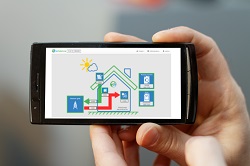Smart technology for more efficient energy use in neighbourhoods
Reducing consumption is only a partial solution to achieving energy efficiency, as is applying energy sources without smart management systems, which may lead to grid failures or wasted energy. ‘Renewable energy isn’t available constantly, but rather in peaks,’ says Professor Peter Langendörfer, project coordinator for the EU-funded project e-balance. ‘When a peak occurs without proper consumption, this energy is wasted, such as renewables disconnected from the grid,’ he adds. ‘When energy consumption is high, renewables may not be available.’ Grid resilience and efficiency through better energy exchange Prof. Langendörfer explains that the grid needs to be able to cope with peak loads if renewable energy and fossil energy providers are to be allowed to add energy whenever they can or want. This makes the grid expensive because of the high load situations. If peaks are avoided, the grid’s investment cost can be reduced. To overcome a mismatch between production and consumption, and an imbalance in the electricity grid, both production and consumption need to be monitored and controlled. ‘Shifting energy needs to when and where energy is provided is one solution,’ says Prof. Langendörfer. ‘e-balance introduced a platform, business models and ICT tools to better manage electrical energy in neighbourhoods.’ A fine balancing act between renewable production and consumption e-balance developed an energy management platform to better balance electrical energy production and demand on every voltage level of the distribution electricity grid. This balance ranges from local neighbourhoods to geographically dispersed groups of users. Sensors and algorithms are used to boost the grid resilience of several functionalities, including fraud detection and location, calculation of losses, and detection and location of fused luminaires. The platform helps people manage their own energy consumption, thus reducing the energy needed and allowing the use of distributed renewable sources. It keeps the energy distribution as local as possible, allowing for the consumption of energy in a certain area instead of letting it travel through the grid for long distances. The innovation reduces the number and duration of failures and helps to increase the quality of energy distribution. Furthermore, the solution can be adapted to any legal requirement and communication infrastructure. Its energy management approach can be applied to all grids. e-balance also designed new business models to achieve an effective energy balance where distribution system operators, energy aggregators, and prosumers (producers and consumers) cooperate seamlessly. According to Prof. Langendörfer, this innovative business model framework has the potential to increase revenues and reduce energy costs. A guidebook was prepared for electricity market and distributed energy operators, city authorities and smart appliance manufacturers to make the most of the project results. It explains how to use the e-balance solution, and can help estimate the improvements that can be made and expected costs. Balancing energy in homes has very little impact on the grid because appliances don’t consume much. Prof. Langendörfer notes that additional means to increase flexibility need to be investigated in the future. Work is now underway in this direction. ‘Energy can be used far more efficiently, resulting in positive impacts for CO2 emissions and the environment overall,’ concludes Prof. Langendörfer. ‘Improving grid management will ultimately lead to better quality of service for end users, who will also be motivated to use photovoltaic panels more efficiently to supply their own energy.’
Keywords
e-balance, energy efficiency, energy production, energy consumption, electricity grid



